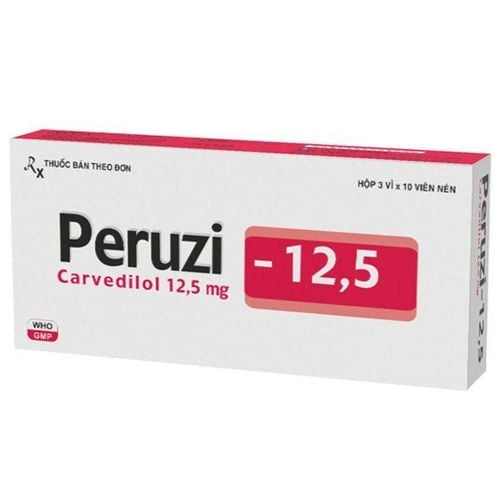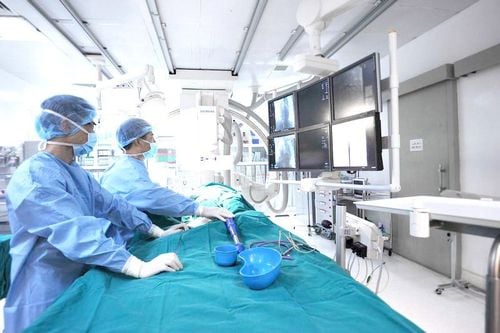This is an automatically translated article.
Those who are suffering from congestive heart failure, hypertension and maintenance therapy are probably interested in the drug peruzi 12 5 or peruzi 12.5. So what are the uses of this drug Peruzi? And how to use ? Read more articles below that will help you understand more about peruzi.
1. What is Peruzi?
Peruzi 12.5 mg is a product manufactured by Dat Vi Phu Pharmaceutical Joint Stock Company - Davipharm, which will be a measure to help treat high blood pressure, treat mild and moderate congestive heart failure due to ischemia. or cardiomyopathy. Thanks to the use of the drug, blood pressure is stabilized and ensures the best health for the patient's body.
Peruzi - 12.5 is prepared in the form of tablets, each tablet contains Carvedilol 12.5 mg, packed in the following specifications: Box of 3 blisters x 10 tablets. Box of 10 blisters x 10 tablets.

Peruzi 12,5 mg là thuốc dùng để điều trị tăng huyết áp, suy tim hiệu quả
2. Pharmacokinetics of the drug Peruzi
2.1. Absorption Carvedilol is not completely absorbed from the gastrointestinal tract and will undergo extensive first-pass metabolism in the liver, so the absolute bioavailability ranges from 20 to 25%. Peak plasma concentrations achieved after oral administration are about 1 - 2 hours. Plasma concentrations increase linearly with dose and within the recommended dose range.
Food prolongs the time to peak serum concentration but will not affect the bioavailability and peak serum concentration of carvedilol.
2.2. Distribution Carvedilol is highly lipophilic. In the blood, the drug is bound to plasma proteins about 98-99%. The volume of distribution is about 2 L/kg and increases with cirrhosis.
2.3. Metabolism Studies in humans and several animal species have shown that carvedilol is extensively metabolised in the liver to various metabolites, which are subsequently excreted in the bile. The effect of first-pass metabolism through the liver after oral administration is about 60-75%.
Carvedilol is extensively metabolised in the liver, glucuronide conjugation is also one of the major reactions. Demethylation and hydroxylation at the phenol ring yield three metabolites with beta-receptor blocking activity.
Based on preclinical studies, the beta-blocking activity of the 4-hydroxyphenol metabolite is approximately 13-fold higher than carvedilol. 3 active metabolites have weaker vasodilator activity than carvedilol.
In humans, concentrations of these substances are about 10 times lower than that of the parent substance. Two of the carbazol-hydroxy metabolites are potent antioxidants and are 30-80 times more potent than carvedilol.
2.4. Elimination The half-life of carvedilol is approximately 6 - 10 hours after oral administration. Plasma clearance will be about 500 - 700 mL/min. The drug is excreted mainly in the bile and will be eliminated mainly in the faeces.
Only about 15% of an oral dose is eliminated by the kidneys. Therefore, no dose adjustment of carvedilol is required in patients with renal impairment.
2.5. Pharmacokinetics in special populations Patients with renal impairment In some hypertensive patients with moderate to severe renal impairment (ClCr < 30 mL/min), plasma concentrations of carvedilol were increased by approximately 40-50% compared with patients with renal impairment. have normal kidney function. Peak plasma concentrations in patients with impaired renal function are also increased by about 10-20%. However, this result is highly variable. Since carvedilol is eliminated mainly in the faeces, there is no significant accumulation of the drug in patients with renal impairment.
No dose adjustment is required in patients with moderate to severe renal impairment.
Patients with hepatic impairment In patients with cirrhosis, the systemic availability of carvedilol is increased by 80% due to a decrease in first-pass metabolism. Therefore, the use of carvedilol is contraindicated in patients with clinically manifest hepatic impairment.
Elderly Age has a statistically significant effect on the pharmacokinetic parameters of carvedilol in hypertensive patients. Studies in elderly hypertensive patients showed no difference in adverse events in this age group compared with younger patients. Another study that also included elderly subjects with coronary artery disease showed no difference in reported adverse events compared with younger subjects.
Children Information on pharmacokinetics in this age group is limited.
Patients with diabetes
In hypertensive patients with type 2 diabetes, no effect of carvedilol on blood glucose (at satiety or fasting) and glycosylated hemoglobin A1, was not required to change the dose of the antidiabetic agents. diabetes treatment.
In patients with type 2 diabetes, carvedilol will not have a statistically significant effect on the glucose tolerance test.
In hypertensive patients without diabetes with altered insulin sensitivity (syndrome X), carvedilol increases insulin sensitivity. Similar results have been reported in hypertensive patients with type 2 diabetes.
Heart failure patients In a study of 24 patients with heart failure, clearance of R- and S-carvedilol was significantly lower. compared with healthy volunteers. These results suggest that the pharmacokinetics of R- and S-carvedilol are significantly altered in patients with heart failure.

Bệnh nhân suy gan có biểu hiện vàng da chống chỉ định với thuốc peruzi
3. Uses of peruzi drug 12.5
Carvedilol is a racemic mixture that nonselectively blocks beta-adrenergic receptors but selectively blocks alpha1-adrenergic receptors. Uses of the drug peruzi 12.5 include:
Treatment of hypertension: Dilatrend is indicated in the treatment of primary hypertension. It may be used alone or in combination with other antihypertensive agents (eg, calcium channel blockers, diuretics). Treatment of coronary artery disease: Carvedilol is clinically effective in the treatment of coronary artery disease. Preliminary data suggest that the drug is effective and safe when used in asymptomatic patients with unstable angina and myocardial ischemia. Treatment of Chronic Heart Failure: Unless contraindicated, carvedilol is indicated in combination with standard therapy (including ACE inhibitors and diuretics and with or without digitalis) to treat all patients with stable, symptomatic, mild, moderate to severe chronic heart failure, with or without ischemic etiology. Left ventricular failure after acute myocardial infarction: After myocardial infarction, there will be complications of left ventricular failure (left ventricular ejection fraction (LVEF) < 40% or contractility index < 1.3). and long-term treatment of post-myocardial infarction patients with carvedilol in combination with ACE inhibitors and other therapies is required.
4. How to use peruzi 12 5
How to use: The drug is taken orally, the tablet must be swallowed with enough water.
Duration of treatment: Treatment with carvedilol is a long-term therapy. As with all β-blockers, treatment should not be stopped abruptly, but the dose should be reduced gradually weekly. This is especially important in the case of patients with concomitant coronary artery disease.
5. Dosage of drug peruzi 12 5
5.1. Hypertension Carvedilol can be used as monotherapy in the treatment of hypertension or in combination with other antihypertensive agents, especially diuretics. Once-daily dosing is recommended, however, a maximum single dose of 25 mg and a maximum daily dose of 50 mg is recommended.
Adults The recommended starting dose is 12.5 mg once daily. After 2 days, increase to 25 mg x 1 time / day. If necessary, the dose can be gradually increased with intervals of at least 2 weeks.
Elderly The recommended starting dose is 12.5 mg once daily and may also be fully effective with continued treatment. However, if the response is inadequate, it can be increased gradually. dose at least 2 weeks apart.

Dùng thuốc peruzi theo chỉ định của bác sĩ
Adults The recommended starting dose is 12.5 mg twice daily for 2 days. Then continue treatment with a dose of 25 mg x 2 times a day. If necessary, the dose may be increased gradually at intervals of at least 2 weeks to a maximum recommended dose of 100 mg/day in 2 divided doses.
Elderly The recommended starting dose is 12.5 mg twice daily. Thereafter, continue treatment with the maximum recommended daily dose of 25 mg twice daily.
5.3. Heart failure Carvedilol is used as an adjunct to usual baseline therapy with diuretics, ACE inhibitors, digitalis, and/or vasodilators. Patients should be clinically stable (no change in NYHA group, no hospitalization for heart failure) and baseline therapy should be stabilized for at least 4 weeks prior to treatment. In addition, the patient should also have a decrease in left ventricular ejection fraction and heart rate > 50 beats/min and systolic blood pressure > 85 mmHg.
The recommended starting dose is 3.125 mg twice daily for 2 weeks. Thereafter, the dose may be increased, if tolerated, to 6.25 mg twice daily. The dose may be increased if tolerated and spaced at least 2 weeks apart to the maximum recommended dose of 25 mg twice daily for patients weighing less than 85 kg or 50 mg twice daily. for people weighing more than 85kg or with mild or moderate heart failure.
Increasing the dose to 50 mg twice daily should be done with caution under the supervision of a specialist.
Transient worsening of heart failure symptoms that are likely to occur at the start of treatment or when the dose is increased, especially in patients with severe heart failure and/or on high-dose diuretics, usually do not require discontinuation of therapy. treatment, but the dose should not be increased. Patients should be monitored within 2 hours of starting or increasing the dose. Before each dose increase, a risk assessment should be performed for worsening symptoms of heart failure or symptoms of excessive vasodilation (eg, renal function, body weight, heart rate).
Worsening heart failure or fluid retention is treated by increasing the diuretic dose, and the carvedilol dose should not be increased until the patient is stable. If bradycardia or prolongation of atrioventricular conduction occurs, digoxin levels should be monitored first. It may sometimes be necessary to reduce the carvedilol dose or temporarily discontinue treatment. Even in these cases, carvedilol dose adjustments can often be successfully continued.
Renal function, platelets and glucose (in the case of insulin-dependent and/or non-insulin-dependent diabetic patients) should be regularly monitored when titrating the dose. However, after dose adjustment, the frequency of monitoring may be reduced.
If carvedilol has been discontinued for more than 2 weeks, treatment should be restarted at 3.125 mg twice daily and gradually increased as recommended above.
5.4. Dosage in Special Populations Impaired Renal Function Dosage should be determined on an individual basis, but based on pharmacokinetic parameters, there is no evidence that carvedilol is titrated for patients with impaired renal function. Renal function is not required.
Moderate hepatic dysfunction No dose adjustment required. Children (<18 years): The use of carvedilol in children under 18 years of age is not recommended due to insufficient information on the safety and efficacy of carvedilol in this patient population. Elderly: The elderly may be more sensitive to the effects of carvedilol and should be carefully monitored. As with other beta-blockers and especially in patients with coronary artery disease, the discontinuation of carvedilol should be gradual. Note: The above dosage is for reference only. The specific dose depends on the condition and the progression of the disease. To get the right dose, you need to consult with your doctor or medical professional.

Thuốc peruzi không được khuyến cáo dùng cho trẻ em dưới 18 tuổi
5.5. What to do in case of an overdose? Symptoms and signs:
In case of overdose, severe hypotension, bradycardia, heart failure, cardiogenic shock and cardiac arrest are possible. Respiratory problems, bronchospasm, vomiting, confusion, and generalized seizures may also occur.
Treatment:
In addition to general supportive treatment, important parameters should be monitored and adjusted, if necessary, in intensive care conditions Atropin can be used when the heart rate is too slow, while , to support ventricular function, the use of intravenous glucagon or sympathomimetic agents (dobutamine, isoprenaline) is recommended.
If vasoconstrictor stimulation is required, phosphodiesterase (PDE) inhibitors should be considered. If peripheral vasodilator effects predominate, norepinephrine or noradrenaline should be used with continuous circulatory monitoring. In cases of bradycardia unresponsive to medication, the use of a pacemaker should be initiated.
For bronchospasm, beta sympathomimetic drugs (nebulized or intravenous), or aminophyline slow intravenous injection or infusion should be used.
In case of convulsions, slow intravenous injection of diazepam or clonazepam is recommended.
Carvedilol is strongly bound to plasma proteins. Therefore, the drug will not be able to be removed by hemodialysis.
In case of severe overdose with symptoms of shock, supportive treatment should be continued for a long time, e.g. until the patient's condition is stabilized, as there may be a prolongation of the half-life and redistribution of carvedilol from deeper compartments.
5.6. What to do if you miss a dose? If you forget a dose, use it as soon as you remember. However, if it is almost time for your next dose, skip the missed dose and take your next dose at the scheduled time. Note that double the prescribed dose should not be used.
6. Precautions when using Peruzi 12.5mg
Chronic Congestive Heart Failure: For patients with congestive heart failure, worsening of heart failure or fluid retention may occur during titration of carvedilol. If these symptoms occur, the dose of the diuretic should be increased and the dose of carvedilol should not be increased until these symptoms have stabilized clinically. Occasionally, it may be necessary to reduce the dose of carvedilol or, in rare cases, to discontinue the drug. Care should be taken when using carvedilol in combination with digitalis glycosides, because both drugs will slow down atrioventricular conduction.
Renal function in congestive heart failure: Reversible decline in renal function has been observed with the administration of carvedilol to patients with chronic heart failure with low blood pressure (systolic blood pressure < l00 mmHg). , ischemic heart disease and disseminated vascular disease, and/or underlying renal failure.
Left ventricular failure after acute myocardial infarction: Before starting treatment with carvedilol, the patient must be clinically stable and should be treated with an ACE inhibitor for a minimum of 48 hours. with a constant dose throughout at least the first 24 hours.
Slow heart rate: Carvedilol can slow your heart rate. If the patient's pulse falls below 55 beats per minute, the carvedilol dose should be reduced.
Prinzmetal variant angina: Drugs with non-selective beta-blocking action may lead to chest pain in patients with Prinzmetal's angina. Care should be taken when administering carvedilol to patients with suspected Prinzmetal angina.
Chronic Obstructive Pulmonary Disease: Care should be taken when administering carvedilol to patients with chronic obstructive pulmonary disease (COPD) associated with bronchospasm who do not require aerosol or oral therapy. carvedilol should only be used in these patients if the potential benefits outweigh the potential risks.
Diabetes: Care should be taken when using carvedilol in patients with diabetes.
Thyroid toxicity: Like other beta-blockers, carvedilol may mask the symptoms of thyrotoxicosis.
Pheochromocytoma: Care should be taken when administering carvedilol to patients with suspected pheochromocytoma.
Hypersensitivity: Care should be taken when using carvedilol in patients with a history of severe hypersensitivity reactions and in patients receiving desensitization therapy.
Serious Skin Adverse Reactions: carvedilol should be permanently discontinued in patients who have experienced serious cutaneous adverse reactions due to carvedilol.
Psoriasis: Patients with a history of psoriasis that would be relevant to treatment with a β-blocker should only receive carvedilol after careful consideration of the risks and benefits of its use.
Contact lens wearers: Contact lens wearers should be aware of the drug's ability to reduce tear secretion.
Discontinuation syndrome: Carvedilol treatment should not be stopped abruptly, especially in patients with ischemic heart disease. The use of carvedilol should be discontinued gradually (over a two-week period).

Cần thận trọng khi sử dụng Peruzi 12.5mg nếu bạn có tiền sử bệnh vẩy nến
7. Side effects of the drug Peruzi 12.5mg
Nervous: Dizziness, headache. Heart: Heart failure. Pulse: Low blood pressure. Body as a whole: Asthenia (fatigue). Infections and Parasites: Bronchitis, pneumonia, upper respiratory tract infections, and urinary tract infections. Blood and lymphatic system: Anemia. Metabolism and nutrition: Weight gain, hypercholesterolemia, decreased glycemic control (hyperglycemia, hypoglycemia) in prediabetes. Psychiatric: Depression and depressed mood. Eyes: Impaired vision, decreased tear production (dry eyes) and eye irritation. Cardiac: Bradycardia, angioedema, hypervolemia and fluid retention. Pulse: Postural hypotension and peripheral circulatory disorders (cold extremities, peripheral vascular disease, exacerbation of claudication and Raynaud's phenomenon Respiratory, thoracic and mediastinal: Dyspnea, edema). lung, bronchial asthma in patients with pre-existing risk factors Gastrointestinal: Nausea, diarrhea, vomiting, dyspepsia and abdominal pain Muscle - bone and connective tissue: Headache and muscle pain. - urology: Renal failure and renal dysfunction in patients with diffuse vascular disease and/or at risk of impaired renal function and urinary disorders Systemic: Pain.
Please dial HOTLINE for more information or register for an appointment HERE. Download MyVinmec app to make appointments faster and to manage your bookings easily.













